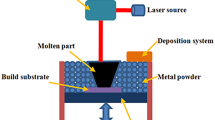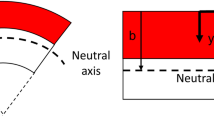Abstract
Residual stress in additive manufacturing (AM) is one of the key challenges in terms of structural integrity and the finish quality of printed components. Estimating the distribution of residual stresses in additively manufactured components is complex and computationally expensive with full-scale thermo-mechanical FE analysis. In this study, a point heat source is utilized to predict the thermal field and residual stress distribution during the manufacturing processes. Numerical results show that the residual stress at a single material point can be expressed as a function of its spatial position and the peak nodal temperature it has experienced during thermal cycles. The distribution of residual stress can be divided into three segments according to the peak nodal temperature. The peak nodal temperature only depends on the heat flux and the distance to the point heat source center. A semi-analytical approach to predict the peak nodal temperature and residual stresses, once the heat flux is known, is proposed. The proposed approach is further validated by a numerical case study, and a very good agreement has been achieved. Compared with traditional thermo-mechanical FE analysis of additive manufacturing, the proposed method significantly improves the computational efficiency, showing great potential for prediction of residual stresses and distortion.

























Similar content being viewed by others
Abbreviations
- d :
-
Distance to point heat source center
- E :
-
Young’s modulus
- q :
-
Heat flux
- a:
-
Radius of point heat source
- R:
-
Radius of axisymmetric model
- H:
-
Height of axisymmetric model
- T p :
-
Peak temperature the node has experienced during thermal cycles
- T m :
-
Maximum temperature the model has experienced during thermal cycles
- T r :
-
Room temperature
- T mel :
-
Melting temperature
- T e, 1 :
-
First critical temperature in three-segment equivalent residual stress model
- T e, 2 :
-
Second critical temperature in three-segment equivalent residual stress model
- T 1, 1 :
-
First critical temperature in three-segment maximum principal residual stress model
- T 1, 2 :
-
Second critical temperature in three-segment maximum principal residual stress model
- θ :
-
The angle to heat surface
- a :
-
The coefficient of thermal expansion
- ε radiation :
-
Radiation coefficient
- h convection :
-
Convection coefficient
- ε * :
-
Inherent strain
- ε P :
-
Plastic strain
- ε T :
-
Thermal plastic strain
- ε X :
-
Phase transformation strain
- σ Y :
-
Yield stress
- σ res :
-
Residual stress
- \( {\sigma}_e^{res} \) :
-
Von Mises equivalent residual stress
- \( {\sigma}_1^{res} \) :
-
Maximum principal residual stress
- \( {\sigma}_{e,1}^{res} \) :
-
First critical equivalent residual stress
- \( {\sigma}_{e,2}^{res} \) :
-
Second critical equivalent residual stress
- \( {\sigma}_{1,1}^{res} \) :
-
First critical maximum principal residual stress
- \( {\sigma}_{1,2}^{res} \) :
-
Second critical maximum principal residual stress
References
Kranz J, Herzog D, Emmelmann C (2015) Design guidelines for laser additive manufacturing of lightweight structures in TiAl6V4. J Laser Appl 27(S1):S14001. https://doi.org/10.2351/1.4885235
Carroll BE, Palmer TA, Beese AM (2015) Anisotropic tensile behavior of Ti–6Al–4V components fabricated with directed energy deposition additive manufacturing. Acta Mater 87:309–320. https://doi.org/10.1016/j.actamat.2014.12.054
Brandl E, Palm F, Michailov V, Viehweger B, Leyens C (2011) Mechanical properties of additive manufactured titanium (Ti–6Al–4V) blocks deposited by a solid-state laser and wire. Mater Des 32(10):4665–4675. https://doi.org/10.1016/j.matdes.2011.06.062
Mercelis PKJ (2006) Residual stresses in selective laser sintering and selective laser melting. Rapid Prototyp 12(5):254–265
Gary K, Lewis ES (2000) Practical considerations and capabilities for laser assisted direct metal deposition. Mater Des 21:417–423
Deng D (2009) FEM prediction of welding residual stress and distortion in carbon steel considering phase transformation effects. Mater Des 30(2):359–366. https://doi.org/10.1016/j.matdes.2008.04.052
Labudovic MHD, Kovacevic R (2003) A three dimensional model for direct laser metal powder deposition and rapid prototyping. J Mater Sci 38(1):35–49
Smith J, Xiong W, Yan W, Lin S, Cheng P, Kafka OL, Wagner GJ, Cao J, Liu WK (2016) Linking process, structure, property, and performance for metal-based additive manufacturing: computational approaches with experimental support. Comput Mech 57(4):583–610. https://doi.org/10.1007/s00466-015-1240-4
Songa JL, Dowson AL, Jacobsa MH, Brooksb J, Bedenc I (2002) Coupled thermo-mechanical finite-element modelling of hot ring rolling process. J Mater Process Technol 121:332–340
Zhang Z, Zhang HW (2007) A fully coupled thermo-mechanical model of friction stir welding. Int J Adv Manuf Technol 37(3-4):279–293. https://doi.org/10.1007/s00170-007-0971-6
Yuan MG, Ueda Y Prediction of residual stresses in welded T- and l-joints using inherent strains. J Eng Mater Technol 118(2):229–234
Li C, Fu CH, Guo YB, Fang FZ (2016) A multiscale modeling approach for fast prediction of part distortion in selective laser melting. J Mater Process Technol 229:703–712. https://doi.org/10.1016/j.jmatprotec.2015.10.022
Yang Y, Ayas C (2017) Computationally efficient thermal-mechanical modelling of selective laser melting. 1892:040005. doi:https://doi.org/10.1063/1.5008031
Mukherjee T, Manvatkar V, De A, DebRoy T (2017) Mitigation of thermal distortion during additive manufacturing. Scr Mater 127:79–83. https://doi.org/10.1016/j.scriptamat.2016.09.001
Mukherjee T, Zuback JS, De A, DebRoy T (2016) Printability of alloys for additive manufacturing. Sci Rep 6:19717. https://doi.org/10.1038/srep19717
Cheng W (2005) In-plane shrinkage strains and their effects on welding distortion in thin-wall structures. The Ohio State University, Ohio
Camilleri D, Comlekci T, Gray TGF (2005) Computational prediction of out-of-plane welding distortion and experimental investigation. J Strain Anal Eng Des 40(2):161–176. https://doi.org/10.1243/030932405x7809
Ding J, Colegrove P, Mehnen J, Williams S, Wang F, Almeida PS (2013) A computationally efficient finite element model of wire and arc additive manufacture. Int J Adv Manuf Technol 70(1-4):227–236. https://doi.org/10.1007/s00170-013-5261-x
Radaj D (1992) Heat effects of welding: temperature field, residual stress, distortion. Springer Science & Business Media, Berlin
Chao CK, Chen FM, Shen MH (2006) Green's functions for a point heat source in circularly cylindrical layered media. J Therm Stresses 29:809–847. https://doi.org/10.1080/01495730600705430
Pratik P, Shukla PTS, Colin J (2014) Laser shock peening and mechanical shot peening processes applicable for the surface treatment of technical grade ceramics: a review. J Eng Manuf 228(5):639–652. https://doi.org/10.1177/0954405413507250
Hasebe KYN (1999) Green's function for a heat source in an infinite region with an arbitrary shaped hole. J Appl Mech 66:204–210
Nazemi N (2015) Identification of the mechanical properties in the heat-affected zone of aluminum welded structures. University of Windsor, Windsor
Meco SAM (2016) Joining of steel to aluminium alloys for advanced structural applications. Cranfield University, Cranfield
Ding J (2012) Thermo-mechanical analysis of wire and arc additive manufacturing process. Cranfield University, Cranfield
Michaleris P, Feng Z, Campbell G (1997) Evaluation of 2D and 3D FEA models for predicting residual stress and distortion. ASME PVP- Approximate Methods in the Design and Analysis of Pressure Vessels and Piping Components 347:91–102
Martukanitz R, Michaleris P, Palmer T, DebRoy T, Liu Z-K, Otis R, Heo TW, Chen L-Q (2014) Toward an integrated computational system for describing the additive manufacturing process for metallic materials. Addit Manuf 1-4:52–63. https://doi.org/10.1016/j.addma.2014.09.002
DebRoy T, Wei HL, Zuback JS, Mukherjee T, Elmer JW, Milewski JO, Beese AM, Wilson-Heid A, De A, Zhang W (2018) Additive manufacturing of metallic components – process, structure and properties. Prog Mater Sci 92:112–224. https://doi.org/10.1016/j.pmatsci.2017.10.001
Ueda Y, Fukuda K, Nakacho K, Endo S (1975) A new measuring method of residual stresses with the aid of finite element method and reliability of estimated values. Soc Nav Archit:499-507
Okerblom NO (1958) The calculations of deformations of welded metal structures. Her Majesty’s Stationery Office, London
Funding
The Chinese Scholarship Council is greatly acknowledged for financial support. The authors wish to thank the Research Council of Norway for funding through the BIA Program, Contract No. 269558/O20.
Author information
Authors and Affiliations
Corresponding author
Additional information
Publisher’s note
Springer Nature remains neutral with regard to jurisdictional claims in published maps and institutional affiliations.
Rights and permissions
About this article
Cite this article
Sun, L., Ren, X., He, J. et al. A new method to estimate the residual stresses in additive manufacturing characterized by point heat source. Int J Adv Manuf Technol 105, 2415–2429 (2019). https://doi.org/10.1007/s00170-019-04443-1
Received:
Accepted:
Published:
Issue Date:
DOI: https://doi.org/10.1007/s00170-019-04443-1




